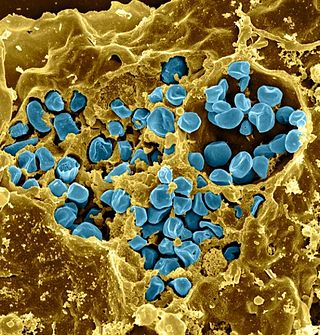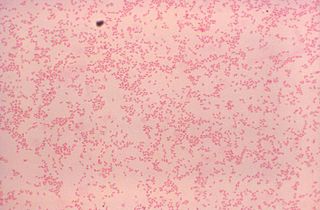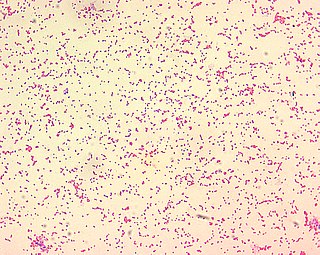Related Research Articles

Sin Nombre orthohantavirus (SNV), a member of the genus Orthohantavirus, is the prototypical etiologic agent of hantavirus cardiopulmonary syndrome (HCPS).

Francisella tularensis is a pathogenic species of Gram-negative coccobacillus, an aerobic bacterium. It is nonspore-forming, nonmotile, and the causative agent of tularemia, the pneumonic form of which is often lethal without treatment. It is a fastidious, facultative intracellular bacterium, which requires cysteine for growth. Due to its low infectious dose, ease of spread by aerosol, and high virulence, F. tularensis is classified as a Tier 1 Select Agent by the U.S. government, along with other potential agents of bioterrorism such as Yersinia pestis, Bacillus anthracis, and Ebola virus. When found in nature, Francisella tularensis can survive for several weeks at low temperatures in animal carcasses, soil, and water. In the laboratory, F. tularensis appears as small rods, and is grown best at 35–37 °C.

Brucella is a genus of Gram-negative bacteria, named after David Bruce (1855–1931). They are small, nonencapsulated, nonmotile, facultatively intracellular coccobacilli.

Babesia, also called Nuttallia, is an apicomplexan parasite that infects red blood cells and is transmitted by ticks. Originally discovered by the Romanian bacteriologist Victor Babeș in 1888, over 100 species of Babesia have since been identified.
Mycobacterium microti is a member of the Mycobacterium tuberculosis complex (MTBC) known as the 'Vole bacillus', first described as a pathogen of field voles in England.
Bartonella quintana, originally known as Rochalimaea quintana, and "Rickettsia quintana", is a bacterium transmitted by the human body louse that causes trench fever. This bacterial species caused outbreaks of trench fever affecting 1 million soldiers in Europe during World War I.

Brucella canis is a Gram-negative bacterium in the family Brucellaceae that causes brucellosis in dogs and other canids. It is a non-motile short-rod or coccus-shaped organism, and is oxidase, catalase, and urease positive. B. canis causes infertility in both male and female dogs. It can also cause inflammation in the eyes. The hosts of B. canis ranges from domestic animals to foxes and coyotes. It is passed from species to species via genital fluids. Treatments such as spaying, neutering, and long-term antibiotics have been used to combat B. canis. The species was first described in the United States in 1966 where mass abortions of beagles were documented. Brucella canis can be found in both pets and wild animals and lasts the lifespan of the animal it has affected. B. canis has two distinct circular chromosomes that can attribute to horizontal gene transfer.

Staphylococcus is a genus of Gram-positive bacteria in the family Staphylococcaceae from the order Bacillales. Under the microscope, they appear spherical (cocci), and form in grape-like clusters. Staphylococcus species are facultative anaerobic organisms.
Staphylococcus microti is a Gram-positive, coagulase-negative member of the bacterial genus Staphylococcus consisting of clustered cocci. This species was originally isolated from viscera of the common vole, Microtus arvalis. It is genetically similar to Staphylococcus rostri.
αr7 is a family of bacterial small non-coding RNAs with representatives in a broad group of Alphaproteobacterial species from the order Hyphomicrobiales. The first member of this family was found in a Sinorhizobium meliloti 1021 locus located in the chromosome (C). Further homology and structure conservation analysis identified full-length homologs in several nitrogen-fixing symbiotic rhizobia, in the plant pathogens belonging to Agrobacterium species as well as in a broad spectrum of Brucella species. αr7 RNA species are 134-159 nucleotides (nt) long and share a well defined common secondary structure. αr7 transcripts can be catalogued as trans-acting sRNAs expressed from well-defined promoter regions of independent transcription units within intergenic regions (IGRs) of the Alphaproteobacterial genomes.
αr45 is a family of bacterial small non-coding RNAs with representatives in a broad group of α-proteobacteria from the order Hyphomicrobiales. The first member of this family (Smr45C) was found in a Sinorhizobium meliloti 1021 locus located in the chromosome (C). Further homology and structure conservation analysis identified homologs in several nitrogen-fixing symbiotic rhizobia, in the plant pathogens belonging to Agrobacterium species as well as in a broad spectrum of Brucella species, in Bartonella species, in several members of the Xanthobactereacea family, and in some representatives of the Beijerinckiaceae family. αr45C RNA species are 147-153 nt long and share a well defined common secondary structure. All of the αr45 transcripts can be catalogued as trans-acting sRNAs expressed from well-defined promoter regions of independent transcription units within intergenic regions (IGRs) of the α-proteobacterial genomes.
Tula orthohantavirus, formerly Tula virus (TULV), is a single-stranded, negative-sense RNA virus species of orthohantavirus first isolated from a European common vole found in Central Russia. It causes Hantavirus hemorrhagic fever with renal syndrome. The Microtus species are also found in North America, Europe, Scandinavia, Slovenia, Asia, and Western Russia. Human cases of Tula orthohantavirus have also been reported in Switzerland and Germany.
Brucella anthropi is a bacterium. The type strain is strain CIP 82.115. O. anthropi strains are rod-shaped, aerobic, gram-negative, non-pigmented and motile by means of peritrichous flagella. They are emerging as major opportunistic pathogens.

Brucella ceti is a gram negative bacterial pathogen of the Brucellaceae family that causes brucellosis in cetaceans. Brucella ceti has been found in both classes of cetaceans, mysticetes and odontocetes. Brucellosis in some dolphins and porpoises can result in serious clinical signs including fetal abortions, male infertility, neurobrucellosis, cardiopathies, bone and skin lesions, stranding events, and death.
Brucella inopinata is a Gram-negative, nonmotile, non-spore-forming coccoid bacterium, first isolated from a breast implant infection site. Its type strain is BO1T. It is a potential cause of brucellosis.
Brucella tritici is a species of bacteria first isolated from wheat rhizoplane. Its type strain is SCII24T.
Brucella intermedia is a bacterium from the genus of Brucella. It was first described by Velasco and others in 1998. It causes diseases in humans only rarely, with single case reports of cholangitis following liver transplantation, bacteremia in a patient with bladder cancer, a pelvic abscess after abdominal surgery, dyspepsia, endophthalmitis in the presence of a foreign body, pneumonia, and endocarditis.
Brucella pecoris is a gram-negative, oxidase-positive, non-spore-forming, rod-shaped non-motile bacteria from the genus of Brucella which was isolated from genitourinary lymph node of a sheep in Bosnia and Herzegovina.
Demodex microti is a hair follicle mite from the skin of the genital area of the common vole, Microtus arvalis.
Giardia microti is a species of Diplomonad parasitic protozoan. Its hosts mainly consist of rodents in the family Cricetidae, which includes voles, mice, rats and muskrats, although they have also been detected from fish.
References
- ↑ Audic S, Lescot M, Claverie JM, Scholz HC (2009). "Brucella microti: the genome sequence of an emerging pathogen". BMC Genomics . 10: 352. doi: 10.1186/1471-2164-10-352 . PMC 2743711 . PMID 19653890.
- ↑ Scholz, H. C.; Hubalek, Z.; Sedlacek, I.; Vergnaud, G.; Tomaso, H.; Al Dahouk, S.; Melzer, F.; Kampfer, P.; Neubauer, H.; Cloeckaert, A.; Maquart, M.; Zygmunt, M. S.; Whatmore, A. M.; Falsen, E.; Bahn, P.; Gollner, C.; Pfeffer, M.; Huber, B.; Busse, H.-J.; Nockler, K. (2008). "Brucella microti sp. nov., isolated from the common vole Microtus arvalis". International Journal of Systematic and Evolutionary Microbiology. 58 (2): 375–382. doi: 10.1099/ijs.0.65356-0 . ISSN 1466-5026. PMID 18218934.
- ↑ Jiménez de Bagüés, María P.; Ouahrani-Bettache, Safia; Quintana, Juan F.; Mitjana, Olga; Hanna, Nabil; Bessoles, Stéphanie; Sanchez, Françoise; Scholz, Holger C.; Lafont, Virginie; Köhler, Stephan; Occhialini, Alessandra (2010). "The New SpeciesBrucella microtiReplicates in Macrophages and Causes Death in Murine Models of Infection". The Journal of Infectious Diseases. 202 (1): 3–10. doi: 10.1086/653084 . ISSN 0022-1899. PMID 20497040.